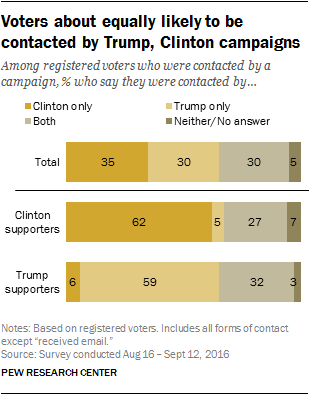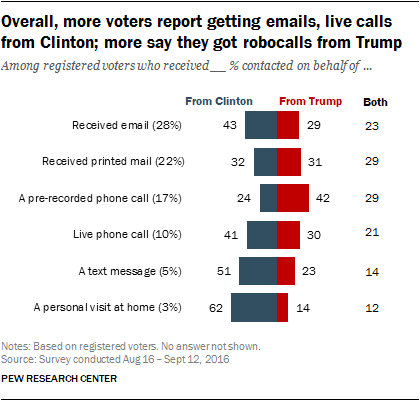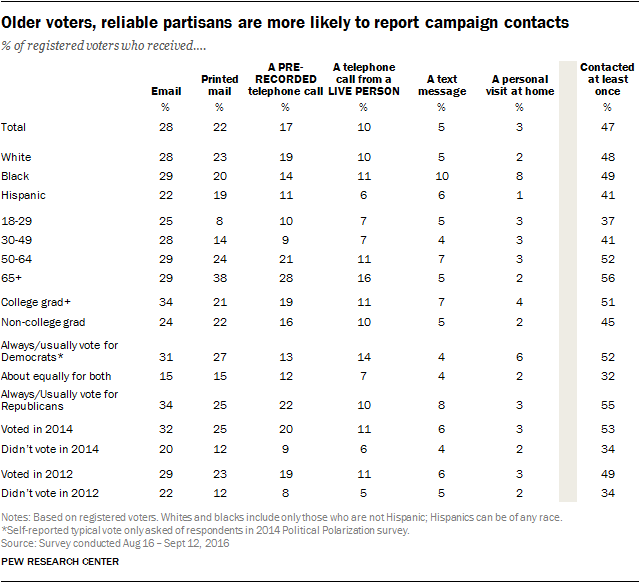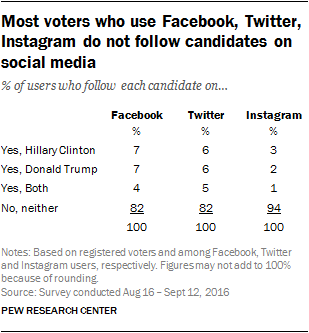Survey report
In the final month before the election, the presidential campaigns are expected to dramatically intensify their voter outreach efforts. Even so, almost half of registered voters (47%) had already received some form of contact from one of the campaigns or groups supporting them as of last month.
 Some forms of outreach are more common than others – with some key differences in the ways Donald Trump and Hillary Clinton supporters have been reached by the campaigns.
Some forms of outreach are more common than others – with some key differences in the ways Donald Trump and Hillary Clinton supporters have been reached by the campaigns.
An early look at voters’ experience with outreach finds that, as of a few months into the campaign, 28% of voters have received an email from at least one of the campaigns, another 22% have received printed mail in support of a candidate, 17% said they got a pre-recorded phone call or “robocall” and 10% said they received a call from a live person.
This is according to a Pew Research Center survey, conducted August 16- September 12, 2016 among 4,538 adults, including 3,941 registered voters, using the Pew Research Center’s American Trends Panel. The Center will continue to track voters’ experiences with the campaigns’ outreach efforts in the next month.
Voters supporting Donald Trump are more likely than Hillary Clinton supporters to report having received a pre-recorded phone call from one of the campaigns (23% vs. 13%), while Clinton supporters are more likely than Trump supporters to say they have received an email (32% vs 26%). Nearly identical percentages of voters supporting Trump and Clinton report having received a piece of printed mail (25% of Trump supporters, 22% of Clinton supporters) or a phone call from a live person (11% of supporters from each campaign).
 Of those who have been contacted on behalf of one of the presidential candidate a third of all registered voters have been contacted only in support of Clinton (35%) and about as many have received contact from only the Trump campaign or supporters (30%); an additional 30% say they have been contacted in some form by both campaigns.
Of those who have been contacted on behalf of one of the presidential candidate a third of all registered voters have been contacted only in support of Clinton (35%) and about as many have received contact from only the Trump campaign or supporters (30%); an additional 30% say they have been contacted in some form by both campaigns.
Most supporters of both Clinton (62%) and Trump (59%) have only been contacted on behalf of the candidate they plan to vote for. In part this reflects the effectiveness of modern campaigns in targeting their mobilization efforts to those who support their candidate. About a third of Trump supporters (32%) and a quarter of Clinton backers (27%) have been reached by efforts on behalf of both campaigns, while very few have only been contacted on behalf of the candidate they do not back.
 While overall, voters report having been roughly equally likely to be contacted on behalf of both campaigns, this is not the case across each different type of contact. For instance, among the 28% of voters who have received an email, contact on behalf of Clinton is more common: 68% have received an email from Clinton or groups supporting her, including 43% who have heard only on her behalf. By comparison, 52% have received an email from Trump or groups supporting him and just 29% have been contacted on behalf of Trump but not Clinton. A similar pattern is seen among the just 5% of voters who have received a text on behalf of a candidate.
While overall, voters report having been roughly equally likely to be contacted on behalf of both campaigns, this is not the case across each different type of contact. For instance, among the 28% of voters who have received an email, contact on behalf of Clinton is more common: 68% have received an email from Clinton or groups supporting her, including 43% who have heard only on her behalf. By comparison, 52% have received an email from Trump or groups supporting him and just 29% have been contacted on behalf of Trump but not Clinton. A similar pattern is seen among the just 5% of voters who have received a text on behalf of a candidate.
And voters are more likely to report in-person contact on behalf of Clinton than on behalf of Trump. Among the small share (just 3%) of voters who have been visited on behalf of a candidate, 62% say they have received a visit from just the Clinton campaign or her supporters, compared with 14% from just the Trump campaign or groups supporting him; 13% say they were visited on behalf of both candidates. And those who received phone calls from a live person were also more likely to have spoken with someone supporting Clinton.
One area where supporters of Trump’s candidacy have been more likely to reach out to voters is through the use of pre-recorded phone calls or robocalls. Fully 42% of people who received pre-recorded phone calls say they solely received these calls on behalf of Trump, 24% have solely received them in support of Clinton. About three-in-ten (29%) voters who have received robocalls say they have heard from both Clinton and Trump supporters.
There are significant demographic differences in voter contact. Older voters, in general, are more likely to say they’ve been reached by the 2016 campaigns. Over half of those 65 and older (56%) have reported receiving at least one form of contact by the campaigns, a stark comparison to the 37% of voters 18-29 who say the same. This pattern repeats itself across many forms of contact, with nearly four-in-ten voters over the age of 65 (38%) and just 8% of voters under 30 receiving a piece of printed mail about the campaign. Similarly, older voters are nearly three times more likely to report receiving a pre-recorded phone call and two times more likely to report receiving a live call. There is little difference across age groups, however, in the percent of voters who report receiving an email.

 Voters who have voted in previous elections are more likely to say they have been contacted. On the whole, about half of those who voted in the 2012 general election (49%) said they received contact from the campaigns, compared to about a third (34%) of those who didn’t vote in 2012.
Voters who have voted in previous elections are more likely to say they have been contacted. On the whole, about half of those who voted in the 2012 general election (49%) said they received contact from the campaigns, compared to about a third (34%) of those who didn’t vote in 2012.
Voters who use social media sites have been about equally likely to follow Trump and Clinton on social media, though only about two-in-ten voters who use each site follow either or both candidates on Facebook (18%) or Twitter (17%), and just 6% follow one or both of the candidates on Instagram.


